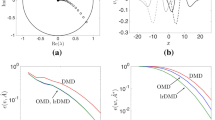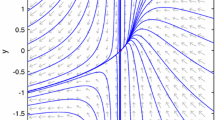Abstract
Identification and control of transient instabilities in high-dimensional dynamical systems remain a challenge because transient (non-normal) growth cannot be accurately captured by reduced-order modal analysis. Eigenvalue-based methods classify systems as stable or unstable on the sole basis of the asymptotic behavior of perturbations and therefore fail to predict any short-term characteristics of disturbances, including transient growth. In this paper, we leverage the power of the optimally time-dependent (OTD) modes, a set of time-evolving, orthonormal modes that capture directions in phase space associated with transient and persistent instabilities, to formulate a control law capable of suppressing transient and asymptotic growth around any fixed point of the governing equations. The control law is derived from a reduced-order system resulting from projecting the evolving linearized dynamics onto the OTD modes and enforces that the instantaneous growth of perturbations in the OTD-reduced tangent space be nil. We apply the proposed reduced-order control algorithm to several infinite-dimensional systems, including fluid flows dominated by normal and non-normal instabilities, and demonstrate unequivocal superiority of OTD control over classical modal control.









Similar content being viewed by others
References
Åkervik, E., Brandt, L., Henningson, D.S., Hœpffner, J., Marxen, O., Schlatter, P.: Steady solutions of the Navier–Stokes equations by selective frequency damping. Phys. Fluids 18, 068102 (2006)
Åström, K.J., Kumar, P.R.: Control: a perspective. Automatica 50, 3–43 (2014)
Babaee, H., Farazmand, M., Haller, G., Sapsis, T.P.: Reduced-order description of transient instabilities and computation of finite-time Lyapunov exponents. Chaos Interdiscip. J. Nonlinear Sci. 27, 063103 (2017)
Babaee, H., Sapsis, T.P.: A minimization principle for the description of modes associated with finite-time instabilities. Proc. R. Soc. A 472, 20150779 (2016)
Balasubramanian, K., Sujith, R.I.: Thermoacoustic instability in a Rijke tube: non-normality and nonlinearity. Phys. Fluids 20, 044103 (2008)
Bayly, B.J.: Three-dimensional instability of elliptical flow. Phys. Rev. Lett. 57, 2160 (1986)
Benettin, G., Galgani, L., Strelcyn, J.M.: Kolmogorov entropy and numerical experiments. Phys. Rev. A 14, 2338 (1976)
Blanchard, A., Sapsis, T.P.: Analytical description of optimally time-dependent modes for reduced-order modeling of transient instabilities (2018) (Submitted to SIAM Journal on Applied Dynamical Systems)
Blanchard, A., Sapsis, T.P.: Stabilization of unsteady flows by reduced-order control with optimally time-dependent modes (2018) (Submitted to Physical Review Fluids)
Chandler, G.J., Kerswell, R.R.: Invariant recurrent solutions embedded in a turbulent two-dimensional Kolmogorov flow. J. Fluid Mech. 722, 554–595 (2013)
Chomaz, J.M.: Global instabilities in spatially developing flows: non-normality and nonlinearity. Annu. Rev. Fluid Mech. 37, 357–392 (2005)
Duriez, T., Brunton, S.L., Noack, B.R.: Machine Learning Control: Taming Nonlinear Dynamics and Turbulence. Springer, Berlin (2017)
Dušek, J., Le Gal, P., Fraunié, P.: A numerical and theoretical study of the first Hopf bifurcation in a cylinder wake. J. Fluid Mech. 264, 59–80 (1994)
Eisenman, I.: Non-normal effects on salt finger growth. J. Phys. Oceanogr. 35, 616–627 (2005)
Farazmand, M.: An adjoint-based approach for finding invariant solutions of Navier–Stokes equations. J. Fluid Mech. 795, 278–312 (2016)
Farazmand, M., Sapsis, T.P.: Dynamical indicators for the prediction of bursting phenomena in high-dimensional systems. Phys. Rev. E 94, 032212 (2016)
Farrell, B.: Optimal excitation of neutral Rossby waves. J. Atmos. Sci. 45, 163–172 (1988)
Fischer, P.F., Lottes, J.W., Kerkemeier, S.G.: nek5000 Web page (2008). http://nek5000.mcs.anl.gov
Foias, C., Manley, O., Rosa, R., Temam, R.: Navier–Stokes Equations and Turbulence. Cambridge University Press, Cambridge (2001)
Giannetti, F., Luchini, P.: Structural sensitivity of the first instability of the cylinder wake. J. Fluid Mech. 581, 167–197 (2007)
Guckenheimer, J., Holmes, P.: Nonlinear Oscillations, Dynamical Systems, and Bifurcations of Vector Fields. Springer, Berlin (1983)
Holmes, P., Lumley, J.L., Berkooz, G.: Turbulence, Coherent Structures, Dynamical Systems and Symmetry. Cambridge University Press, Cambridge (1998)
Juang, J.N., Pappa, R.S.: An eigensystem realization algorithm for modal parameter identification and model reduction. J. Guid. Control Dyn. 8, 620–627 (1985)
Lumley, J.L.: Coherent structures in turbulence. In: Meyer, R.E. (ed.) Transition and Turbulence, pp. 215–242. Academic Press, New York (1981)
Mack, L.M.: The inviscid stability of the compressible laminar boundary layer. Space Prog. Summ. 37, 297–312 (1963)
Moore, B.: Principal component analysis in linear systems: controllability, observability, and model reduction. IEEE Trans. Autom. Control 26, 17–32 (1981)
Orszag, S.A.: Accurate solution of the Orr–Sommerfeld stability equation. J. Fluid Mech. 50, 689–703 (1971)
Orszag, S.A., Patera, A.T.: Secondary instability of wall-bounded shear flows. J. Fluid Mech. 128, 347–385 (1983)
Penland, C., Sardeshmukh, P.D.: The optimal growth of tropical sea surface temperature anomalies. J. Clim. 8, 1999–2024 (1995)
Peplinski, A., Schlatter, P., Fischer, P.F., Henningson, D.S.: Stability tools for the spectral-element code Nek5000: application to jet-in-crossflow. In: Azaïez, M., El Fekih, H., Hesthaven, J.S. (eds.) Spectral and High Order Methods for Partial Differential Equations, pp. 349–359. Springer, Berlin (2014)
Pierrehumbert, R.T.: Universal short-wave instability of two-dimensional eddies in an inviscid fluid. Phys. Rev. Lett. 57, 2157 (1986)
Platt, N., Sirovich, L., Fitzmaurice, N.: An investigation of chaotic Kolmogorov flows. Phys. Fluids A Fluid Dyn. 3, 681–696 (1991)
Proctor, J.L., Brunton, S.L., Kutz, J.N.: Dynamic mode decomposition with control. SIAM J. Appl. Dyn. Syst. 15, 142–161 (2016)
Provansal, M., Mathis, C., Boyer, L.: Bénard-von Kármán instability: transient and forced regimes. J. Fluid Mech. 182, 1–22 (1987)
Reddy, S.C., Henningson, D.S.: Energy growth in viscous channel flows. J. Fluid Mech. 252, 209–238 (1993)
Rowley, C.W.: Model reduction for fluids, using balanced proper orthogonal decomposition. Int. J. Bifurc. Chaos 15, 997–1013 (2005)
Rowley, C.W., Dawson, S.T.M.: Model reduction for flow analysis and control. Annu. Rev. Fluid Mech. 49, 387–417 (2017)
Schmid, P.J.: Nonmodal stability theory. Annu. Rev. Fluid Mech. 39, 129–162 (2007)
Schmid, P.J.: Dynamic mode decomposition of numerical and experimental data. J. Fluid Mech. 656, 5–28 (2010)
Schmid, P.J., Brandt, L.: Analysis of fluid systems: stability, receptivity, sensitivity. Appl. Mech. Rev. 66, 024803 (2014)
Schmid, P.J., Henningson, D.S.: Stability and Transition in Shear flows. Springer, Berlin (2012)
Shimada, I., Nagashima, T.: A numerical approach to ergodic problem of dissipative dynamical systems. Prog. Theor. Phys. 61, 1605–1616 (1979)
Sirovich, L.: Turbulence and the dynamics of coherent structures. Part I: coherent structures. Q. Appl. Math. 45, 561–571 (1987)
Skogestad, S., Postlethwaite, I.: Multivariable Feedback Control: Analysis and Design. Wiley, New York (2007)
Sontag, E.D.: Mathematical Control Theory: Deterministic Finite Dimensional Systems. Springer, Berlin (2013)
Trefethen, L.N., Trefethen, A.E., Reddy, S.C., Driscoll, T.A.: Hydrodynamic stability without eigenvalues. Science 261, 578–584 (1993)
Von Kármán, T.: Über den Mechanismus des Widerstandes, den ein bewegter Körper in einer Flüssigkeit erfährt. Nachrichten von der Gesellschaft der Wissenschaften zu Göttingen, Mathematisch-Physikalische Klasse 1911, 509–517 (1911)
Acknowledgements
The authors gratefully acknowledge insightful discussions with Dr. Mohammad Farazmand.
Funding
This study was supported by Army Research Office Grant W911NF-17-1-0306 and Air Force Office of Scientific Research Grant FA9550-16-1-0231.
Author information
Authors and Affiliations
Corresponding authors
Ethics declarations
Conflict of interest
The authors declare that they have no conflict of interest.
Rights and permissions
About this article
Cite this article
Blanchard, A., Mowlavi, S. & Sapsis, T.P. Control of linear instabilities by dynamically consistent order reduction on optimally time-dependent modes. Nonlinear Dyn 95, 2745–2764 (2019). https://doi.org/10.1007/s11071-018-4720-1
Received:
Accepted:
Published:
Issue Date:
DOI: https://doi.org/10.1007/s11071-018-4720-1




